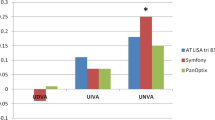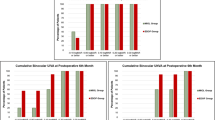Abstract
Purpose
To evaluate reading performance, preferred reading distance, and spectacle independence in patients implanted with a low add multifocal or an extended depth of focus (EDOF) intraocular lens (IOL) after phacoemulsification.
Methods
In this prospective study, patients were randomized into two groups: the diffractive multifocal Tecnis + 2.75 D (ZKB00) IOL (Tecnis + 2.75 group; 15 patients) or the EDOF Tecnis Symfony (ZXR00) IOL (Symfony group; 14 patients) for bilateral implantation with mini-monovision. Reading performance parameters (reading acuity [RA], critical print size [CPS], and maximum reading speed [MRS]) were evaluated with MNREAD acuity charts at 40 cm, and preferred reading distances and spectacle independence for near activities were assessed preoperatively and at the postoperative 1st, 3rd, and 6th months.
Results
At the postoperative 6th month, binocular logMAR UNVA and DCNVA were significantly better in the Symfony group than in the Tecnis + 2.75 group (UNVA: 0.15 ± 0.07 vs. 0.22 ± 0.08, p = 0.046; DCNVA: 0.21 ± 0.05 vs. 0.28 ± 0.07, p = 0.043; respectively). There was no significant difference in reading performance parameters between the groups; however, the Symfony group preferred significantly closer reading distance than the Tecnis + 2.75 group (42.00 ± 4.67 cm; 45.87 ± 5.32 cm, respectively, p = 0.030). At the postoperative 6th month, 14.3% and 26.7% of patients reported that they needed spectacles, rarely or occasionally, for near activities in the Symfony and Tecnis + 2.75 groups, respectively (p > 0.05).
Conclusions
When implanted with mini-monovision, although functional near visual acuity and a high degree of spectacle independence at near distances were achieved with both IOLs, patients implanted with the EDOF IOL preferred closer reading distance than those implanted with the low add diffractive multifocal IOL.


Similar content being viewed by others
References
Pedrotti E, Carones F, Aiello F, a, (2018) Comparative analysis of visual outcomes with 4 intraocular lenses: monofocal, multifocal, and extended range of vision. J Cataract Refract Surg 44(2):156–167
Cardona G, Vega F, Gil MA et al (2018) Visual acuity and image quality in 5 diffractive intraocular lenses. Eur J Ophthalmol 28(1):36–41
Kim JS, Jung JW, Lee JM et al (2015) Clinical outcomes following implantation of diffractive multifocal intraocular lenses with varying add powers. Am J Ophthalmol 160(4):702–709
Hayashi K, Manabe S, Hayashi H (2009) Visual acuity from far to near and contrast sensitivity in eyes with a diffractive multifocal intraocular lens with a low addition power. J Cataract Refract Surg 35(12):2070–2076
Hayashi K, Ogawa S, Manabe S et al (2015) Visual outcomes in eyes with a distance-dominant diffractive multifocal intraocular lens with low near addition power. Br J Ophthalmol 99(11):1466–1470
Petermeier K, Messias A, Gekeler F et al (2011) Effect of +3.00 diopter and +4.00 diopter additions in multifocal intraocular lenses on defocus profiles, patient satisfaction, and contrast sensitivity. J Cataract Refract Surg 37(4):720–726
Rojas MJ, Yeu E (2016) An update on new low add multifocal intraocular lenses. Curr Opin Ophthalmol 27(4):292–297
Vega F, Alba-Bueno F, Millán MS et al (2015) Halo and through-focus performance of four diffractive multifocal intraocular lenses. Invest Ophthalmol Vis Sci 56(6):3967–3975
Madrid-Costa D, Ruiz-Alcocer J, Ferrer-Blasco T et al (2013) Optical quality differences between three multifocal intraocular lenses: bifocal low add, bifocal moderate add, and trifocal. J Refract Surg 29(11):749–754
Akella SS, Juthani VV (2018) Extended depth of focus intraocular lenses for presbyopia. Curr Opin Ophthalmol 29(4):318–322
Nakamura K, Bissen-Miyajima H, Yoshino M et al (2015) Visual performance after contralateral implantation of multifocal intraocular lenses with +3.0 and +4.0 diopter additions. Asia-Pacific J Ophthalmol (Philadelphia, Pa) 4(6):329–333
Ganesh S, Brar S, Pawar A et al (2018) Visual and refractive outcomes following bilateral implantation of extended range of vision intraocular lens with micromonovision. J Ophthalmol 2018:7321794
Coren S, Kaplan CP (1973) Patterns of ocular dominance. Am J Optom Arch Am Acad Optom 50(4):283–292
Idil AS, Çaliskan D, Idil BN (2009) The development and validation of MNREAD acuity charts in Turkish. TJO 39(2):84–90
Mansfield J, Ahn S, Legge G et al (1993) A new reading-acuity chart for normal and low vision. Ophthalmic Vis Opt/Noninvasive Assess Vis Syst Tech Dig 3:232–235
Mencucci R, Favuzza E, Caporossi O et al (2018) Comparative analysis of visual outcomes, reading skills, contrast sensitivity, and patient satisfaction with two models of trifocal diffractive intraocular lenses and an extended range of vision intraocular lens. Graefes Arch Clin Exp Ophthalmol 256(10):1913–1922
Cochener B, Concerto Study G (2016) Clinical outcomes of a new extended range of vision intraocular lens: international multicenter concerto study. J Cataract Refract Surg 42(9):1268–1275
Richter-Mueksch S, Weghaupt H, Skorpik C et al (2002) Reading performance with a refractive multifocal and a diffractive bifocal intraocular lens. J Cataract Refract Surg 28(11):1957–1963
Stifter E, Sacu S, Weghaupt H et al (2004) Reading performance depending on the type of cataract and its predictability on the visual outcome. J Cataract Refract Surg 30(6):1259–1267
Rubin GS, West SK, Munoz B et al (1997) A comprehensive assessment of visual impairment in a population of older Americans. the see study. salisbury eye evaluation project. Invest Ophthalmol Vis Sci 38(3):557–568
Whittaker SG, Lovie-Kitchin J (1993) Visual requirements for reading. Optom Vis Sci 70(1):54–65
Xiong YZ, Calabrese A, Cheong AMY et al (2018) Reading acuity as a predictor of low-vision reading performance. Invest Ophthalmol Vis Sci 59(12):4798–4803
Jackson MA, Edmiston AM, Bedi R (2020) Optimum refractive target in patients with bilateral implantation of extended depth of focus intraocular lenses. Clin Ophthalmol 14:455–462
Attia MSA, Auffarth GU, Kretz FTA, T, et al (2017) Clinical evaluation of an extended depth of focus intraocular lens with the salzburg reading desk. J Refract Surg 33(10):664–669
Attia MS, Khoramnia R, Auffarth GU et al (2016) Near and intermediate visual and reading performance of patients with a multifocal apodized diffractive intraocular lens using an electronic reading desk. J Cataract Refract Surg 42(4):582–590
Akkaya Turhan S, Toker E (2018) Postoperative evaluation of bilateral reading performance with two intraocular lenses: twelve-month results. Eye Contact Lens 44:S233–S237
Monaco G, Gari M, Di Censo F et al (2017) Visual performance after bilateral implantation of 2 new presbyopia-correcting intraocular lenses: trifocal versus extended range of vision. J Cataract Refract Surg 43(6):737–747
Pilger D, Homburg D, Brockmann T et al (2018) Clinical outcome and higher order aberrations after bilateral implantation of an extended depth of focus intraocular lens. Eur J Ophthalmol 28(4):425–432
Hogarty DT, Russell DJ, Ward BM et al (2018) Comparing visual acuity, range of vision and spectacle independence in the extended range of vision and monofocal intraocular lens. Clin Exp Ophthalmol 46(8):854–860
Ruiz-Mesa R, Abengozar-Vela A, Aramburu A et al (2017) Comparison of visual outcomes after bilateral implantation of extended range of vision and trifocal intraocular lenses. Eur J Ophthalmol 27(4):460–465
Kretz FT, Gerl M, Gerl R et al (2015) Clinical evaluation of a new pupil independent diffractive multifocal intraocular lens with a +2.75 D near addition: a European multicentre study. Br J Ophthalmol 99(12):1655–1659
Funding
The authors received financial support from Marmara University (Scientific Research Project Comission; Bilimsel Araştırma Projeleri Komisyonu [BAPKO]).
Author information
Authors and Affiliations
Corresponding author
Ethics declarations
Conflict of interest
The authors have no financial or proprietary interest in a product, method, or material described herein.
Additional information
Publisher's Note
Springer Nature remains neutral with regard to jurisdictional claims in published maps and institutional affiliations.
Rights and permissions
About this article
Cite this article
Turhan, S.A., Sevik, M.O. & Toker, E. Comparison of reading performance with low add bifocal and extended depth of focus intraocular lenses implanted with mini-monovision. Int Ophthalmol 41, 315–323 (2021). https://doi.org/10.1007/s10792-020-01584-1
Received:
Accepted:
Published:
Issue Date:
DOI: https://doi.org/10.1007/s10792-020-01584-1




